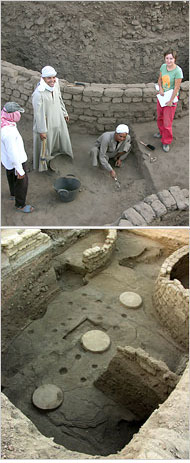
Parts of an administration building, above, and a large silo, top, at the site of an ancient provincial capital on the Upper Nile; Top, N.Moeller/Tell Edfu Project; above, G. Marouard/Tell Edfu Project.
By JOHN NOBLE WILFORD, The New York Times, July 1, 2008
Archaeologists have long fixed their sights on the grandeur that was ancient Egypt, the pyramids, temples and tombs. Few bothered to dig beneath and beyond the monumental stones for glimpses into the living and working spaces of ordinary Egyptians.
That is changing slowly but steadily. In the last two or three decades, excavations have uncovered urban remains and swept aside the conventional wisdom that the Egypt of the pharaohs, in contrast to Mesopotamia, was somehow a civilization without cities.
“We can now confirm that this was not the case,†said Nadine Moeller, an Egyptologist at the Oriental Institute of the University of Chicago. Dr. Moeller was speaking of her own recent findings, as well as those of other excavators who practice what is known as settlement archaeology.
She described the discovery of a large administration building and seven grain silos buried at the site of an ancient provincial capital on the Upper Nile. The partly preserved round silos, more than 3,500 years old, appear to be the largest storage bins known from early Egypt. Seal impressions and other artifacts associated with commodities put a somewhat older date for the central building, with at least 16 columns.
An official announcement of the discovery was made by Zahi Hawass, secretary general of the Supreme Council for Antiquities in Egypt. He is best known for the more spectacular research on mummies and tombs, but is now promoting greater attention to settlement exploration.
“This is a really amazing site, at the cutting-edge of recent Egypt archaeology,†said Stuart Tyson Smith of the University of California, Santa Barbara, who was not involved in the project. “Digging into towns, you get the full range of life, not the very narrow view of society as seen from the top, from the rich and elite.â€
Mark Lehner, an Egyptologist who uncovered remains of settlements for workers who built the pyramids at Giza, said that at Dr. Moeller’s site he inspected layers of sediments showing occupation extending back 5,000 years to the dawn of Egyptian civilization and forward to the early Islamic period in the first millennium A.D. The silos are near temple ruins from about 300 B.C.
“Where there are temples, we are learning, they were surrounded by towns which have usually been overlooked,†Dr. Lehner said.
The site of the recent discovery is at Tell Edfu, halfway between the modern cities of Aswan and Luxor (Thebes in antiquity). For much of Egyptian history, the central government was based in Memphis, in the north, or Thebes. The town at Tell Edfu was an important regional center with close ties to Thebes.
Dr. Moeller and a team of European and Egyptian archaeologists began excavations near the temple there in 2005. They exposed a large courtyard surrounded by mud-brick walls. Underneath the courtyard, they came upon foundations of the first three of the seven silos. From artifacts, the archaeologists dated the silos to the 17th dynasty, 1630 to 1520 B.C.
These storage bins, presumably for barley and emmer wheat, which were used for food and as a medium of exchange, were built of mud brick, with diameters from 18 to 22 feet. If their height was greater than the diameter, as was the usual case, the silos probably stood at least 25 feet tall.
“Their size was a surprise, nothing we had encountered before, certainly not in a town center,†Dr. Moeller said.
In the last three years, the team excavated the column bases and chambers of what they think was the town’s administrative center. The building layout suggests it may have been part of the governor’s palace, and artifacts mark it as the economic heart of town.
Seal impressions, which established the building’s existence in the 13th dynasty, 1773 to 1650 B.C., indicate their use in identifying different commodities. Some seals showed ornamental patterns of spirals and hieroglyphic symbols belonging to different officials. Archaeologists said this was evidence of the activities in the building like accounting and the opening and sealing of boxes and ceramic jars in the course of business transactions.
“The work at Edfu is important in that it allows us to examine ancient Egypt as an urban society,†said Gil Stein, director of the Oriental Institute.
As a specialist in Mesopotamian archaeology, Dr. Stein noted the longstanding assumption that the valley of the Tigris and Euphrates Rivers was “a land of cities and Egypt was something else, because in Egypt we had not been looking at or for cities.â€
Egyptologists credit Manfred Bietak of the University of Vienna, Barry Kemp of Cambridge University in England and Dr. Lehner, now with Ancient Egypt Research Associates in Boston, as leaders in nudging excavators toward research into everyday urban life along the Nile. “It’s a smallish club, but gaining converts,†Dr. Smith said.